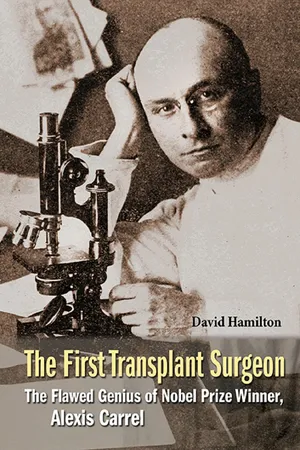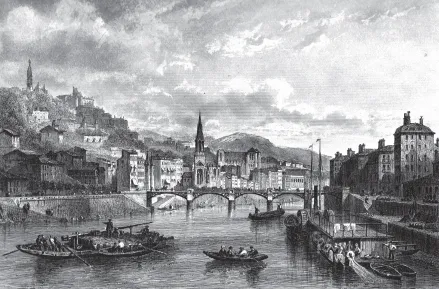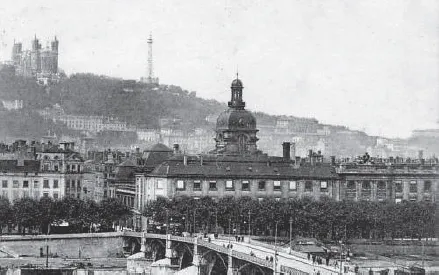
eBook - ePub
The First Transplant Surgeon
The Flawed Genius of Nobel Prize Winner, Alexis Carrel
- 608 pages
- English
- ePUB (mobile friendly)
- Available on iOS & Android
eBook - ePub
About this book
This is a new account, of how, in the early 1900s, the French-born surgeon Alexis Carrel (1873–1944) set the groundwork for the later success in human organ transplantation, and gained America's first Nobel Prize in 1912. His other contributions were the
Frequently asked questions
Yes, you can cancel anytime from the Subscription tab in your account settings on the Perlego website. Your subscription will stay active until the end of your current billing period. Learn how to cancel your subscription.
At the moment all of our mobile-responsive ePub books are available to download via the app. Most of our PDFs are also available to download and we're working on making the final remaining ones downloadable now. Learn more here.
Perlego offers two plans: Essential and Complete
- Essential is ideal for learners and professionals who enjoy exploring a wide range of subjects. Access the Essential Library with 800,000+ trusted titles and best-sellers across business, personal growth, and the humanities. Includes unlimited reading time and Standard Read Aloud voice.
- Complete: Perfect for advanced learners and researchers needing full, unrestricted access. Unlock 1.4M+ books across hundreds of subjects, including academic and specialized titles. The Complete Plan also includes advanced features like Premium Read Aloud and Research Assistant.
We are an online textbook subscription service, where you can get access to an entire online library for less than the price of a single book per month. With over 1 million books across 1000+ topics, we’ve got you covered! Learn more here.
Look out for the read-aloud symbol on your next book to see if you can listen to it. The read-aloud tool reads text aloud for you, highlighting the text as it is being read. You can pause it, speed it up and slow it down. Learn more here.
Yes! You can use the Perlego app on both iOS or Android devices to read anytime, anywhere — even offline. Perfect for commutes or when you’re on the go.
Please note we cannot support devices running on iOS 13 and Android 7 or earlier. Learn more about using the app.
Please note we cannot support devices running on iOS 13 and Android 7 or earlier. Learn more about using the app.
Yes, you can access The First Transplant Surgeon by David Hamilton in PDF and/or ePUB format, as well as other popular books in Medicine & Medicine Biographies. We have over one million books available in our catalogue for you to explore.
Information
Topic
MedicineSubtopic
Medicine BiographiesCHAPTER ONE
Lyon Days
Carrel was born on 28 June 1873 in Lyon in southern France, the nation’s second-largest city. The family lived in a house in the Quai de la Pêcherie on the river in the merchant area of the city.1 This prosperous area was south of the crowded textile factories in the Croix Rousse district, known as the ‘hill that works’, and to the west over the river were the churches on ‘the hill that prays’. Alexis was christened Marie-Joseph-Auguste Carrel-Billiard. Of the three siblings, he was one-and-a-half years older than his brother Joseph, later a local composer and writer, and three years younger than his sister Marguerite. His father, Alexis Carrel-Billiard, worked as a broker in Lyon’s important silk-processing industry, which imported raw materials from their colonies, and the family had been involved in Lyon’s silk and textile industry since the 18th century. On his mother’s side, the Ricards were merchants, politicians and magistrates. The family were devout Catholics and Alexis’ nephew became bishop of Clermont-Ferrand. They had bourgeois attitudes and kept apart from the radicalism and anticlericalism then prominent in Lyon. But Alexis’ father died of pneumonia in 1897, and as was customary, young Alexis, aged five, took his father’s name.2 Thereafter, until leaving France, he used the hyphenated surname Carrel-Billiard, simplifying it only later to Carrel.

The city of Lyon circa 1850: Carrel’s family lived on the right bank of this, the La Saöne river.
Though he was to be a critic later of France and French society, it seems that this was a happy time. Later in life, when concerned about national decline, he wrote that:
Tonight I long for or rather I see the Christmas nights of other years … that charming little life gone forever ... that balanced world, happy above all, made up of those people. … Why have we so degenerated? … Perhaps because our life was too happy ...3
The death meant that the family were left in difficulty. They moved to a smaller house, but the constraints ceased when money was inherited in 1900 after Carrel’s grandfather’s death. As a result, his mother could move to La Bâtie, a comfortable country chateau, in the town of Saint-Martin-en-Haut, 30 miles north of Lyon. Alexis also received a legacy from his grandfather. This gave him a modest income thereafter, one large enough to support him in his first poorly-paid posts in America, and further money came to him after his mother died in 1905. This private income explains much in his life thereafter: at the time, private means were almost essential for a career in medical research.4 Carrel came into other money later. His Nobel Prize in 1912 gave him a substantial cash payment, and he married a rich widow in 1913. To add to this, he later wrote an internationally best-selling book. In short, he never lacked money, and had the freedom of action that this allows.
School Days
French education was largely secular at the time, but Alexis was sent as a day boy to a Jesuit school, the Collège des Jésuites de Saint-Joseph, a short distance from his home. Now called the Lycée Saint-Marc, it was, and is, one of the many respected schools run by the Society of Jesus, the religious order allied to the Roman Catholic Church. Known then as the ‘schoolmasters of Europe’, the Jesuits’ pedagogy sought, as well as teaching an ethical code, to encourage ‘individualism, leadership and reflection’. The teaching was suffused with moral instruction and also encouraged ‘eloquentia perfecta’ — excellence in writing and speaking. But the teaching of mathematics and the sciences was not a priority.5 The Jesuits’ recall an aphorism of Ignatius Loyola, their founder, who said: ‘Give me the child till he is seven, and I will show you the man.’ This schooling gave an obvious input to Carrel’s later thoughts and writings. Although he later had an ambivalent attitude to organised religion, and criticised the Jesuits, he retained much of their outlook. A more practical youthful influence came in summer when the family spent time at his grand-parents’ home in Sainte-Foy, and they were joined there by Uncle Joseph Ricard, an army officer. There he set up a simple experimental laboratory and Alexis was interested in both his military life and the experiments.
At school, Alexis had a good academic record, but not an outstanding one, and in 1890, he took his Science baccalaureate examination, having taken it in Letters in 1889. At this point, he thought of joining the army, like his uncle, but, because he was short-sighted, this career was closed to him. This military bent was fulfilled later, not only during a year of military service in his student days, but also through French army appointments in both World War I and II. A liking for the discipline of military life can be detected in other aspects of his career, notably in the administration of his laboratories and even in his research projects. Instead, at age 17, Carrel enrolled on 1 October 1891 in the faculty of medicine in the local University of Lyon. About 120 students started medical training each year, and 60 others were taught in Lyon at a separate school for military surgeons.
Lyon Student
After two years’ basic studies in anatomy and physiology, Carrel started clinical training in 1893. This Lyon medical teaching involved a series of competitive examinations over four years followed by further tests for those wishing to enter a hospital career. When he took the examination for entry to the first two years of ‘externat’ training, he did well. Next year in 1894, he failed in an attempt to reach the next grade as an ‘internat’. Not discouraged, Carrel took one year out for military service from November 1894 to autumn 1895, where he served as a ‘médecin-auxiliaire’ in the ‘chasseurs alpins’, a mountain regiment trained to protect the border with Italy. After this year out, and a reservist until 1900, he waited until 1896, when he was successful in his second attempt at the exams for an intern surgical post. This involved rotating between the seven surgical units of the Lyon hospitals, many of them in the magnificent ancient Hôtel-Dieu, a hospital of 1,065 beds.
In some accounts of Carrel’s life, it is suggested that medical teaching, surgery and research in Lyon at the time was not particularly distinguished, but this is not the case. In the 1870s reform of the universities, France, including Lyon, had caught up with Germany’s prominence in medicine, notably in accepting the importance of adding laboratory studies to clinical work.6 Thereafter in Europe, France and Germany vied with each other for the world leadership in medicine and surgery. France had the legacy of Claude Bernard’s introduction of scientific methods to the study of living tissue, showing that life mechanisms were not impenetrable but could be understood in physical and chemical terms. Added to this, the world was in awe of Pasteur’s achievements in Paris in establishing the microbial origins of infectious disease, and that there were methods for prevention. Europe’s university-based medical schools and institutes had earlier been copied throughout the world and in America, much earlier, Philadelphia made a start using the Edinburgh medical school as their model. America now studied the continental European medical school research ethos. The rest of the medical world had to be fluent in German and French and this was an extra reason for the American visits. William Halsted, the Hopkins surgeon, spent formative time in France and Germany, as did George Crile.7 Harvey Cushing, like many others, travelled to Europe and spent time in Lyon in 1900, visiting the distinguished research-minded surgical staff. Abraham Flexner toured Europe’s medical schools to investigate and report on best practices for future American medical teaching. He enthused about how France had gone further in ensuring that medical education was linked with clinical medical practice and praised the public hospitals of Lyon. He thought anatomical teaching at Lyon was superior to that in Paris and picked out the medico-legal and hygiene departments for praise.8

Carrel trained at the venerable Hôtel-Dieu hospital on Le Rhöne river in Lyon.
This rite of passage for young Americans would start to fade about 1905, and World War I finally destroyed the European dominance.
Lyon Medicine
As the second city in France, Lyon medicine shared in the competitive and innovative European milieu, particularly in surgery, and Carrel soon had a part in it. In Lyon at this time, the hospitals’ notable surgeons were Antonin Poncet (1849–1913), Louis Léopold Ollier (1830–1900),9 and Mathieu Jaboulay (1860–1913).10 They made the city famous, rivalling Paris in medical practice and research. Jaboulay published on techniques of blood vessel and testis surgery, and pioneered abdominal surgery, being remembered for his stomach by-pass operations and, as described later, he carried out the first attempts at human kidney transplantation. Poncet had the Lyon chair of operative medicine and wrote extensively on urology and the surgery of tuberculosis, and Ollier was famed for his bone grafting methods. All these talented men in Lyon vigorously followed and expanded their countryman Claude Bernard’s advocacy of experimental investigation. Ollier’s studies of bone growth were innovative, and as chief surgeon at the Hôtel Dieu, he was ahead of his time in giving up general surgery to specialise in orthopaedics. Among the Lyon physicians was Léon Bouveret (of his eponymous disease and syndrome)11 and Raphaël Lépine (1840–1919), who contributed to the understanding of diabetes. Lépine was a reforming dean of the Medical School after World War I, attracting Rockefeller Foundation funds to Lyon in the 1920s. These Lyon teachers authored a remarkable number of standard texts, notably those of Testut and Morat. Leo Testut (1849–1925), a surgeon and professor of anatomy, wrote his four-volume, beautifully illustrated Traité d’anatomie humaine (1899), which was the best-selling text of the time and was translated and used widely even until the 1950s. The physiologist Jean-Pierre Morat (1846–1920),...
Table of contents
- Cover
- Halftitle
- Title
- Copyright
- The Author
- Prologue
- Acknowledgements
- Contents
- Chapter One Lyon Days
- Chapter Two New Life in North America
- Chapter Three Early Years at the Institute
- Chapter Four Carrel Established
- Chapter Five The Birth of Tissue Culture
- Chapter Six The Nobel Prize
- Chapter Seven Heart and Blood Vessel Surgery
- Chapter Eight War in France
- Chapter Nine The Demonstration Hospital
- Chapter Ten Early 1920s Research
- Chapter Eleven Life in the 1920s
- Chapter Twelve Confidence Gone
- Chapter Thirteen His Book — Man, the Unknown
- Chapter Fourteen The Organ Pump
- Chapter Fifteen Wider Involvement
- Chapter Sixteen Retirement Nears
- Chapter Seventeen To France and Back
- Chapter Eighteen Back to France
- Chapter Nineteen Aftermath
- Bibliography and Sources
- Index